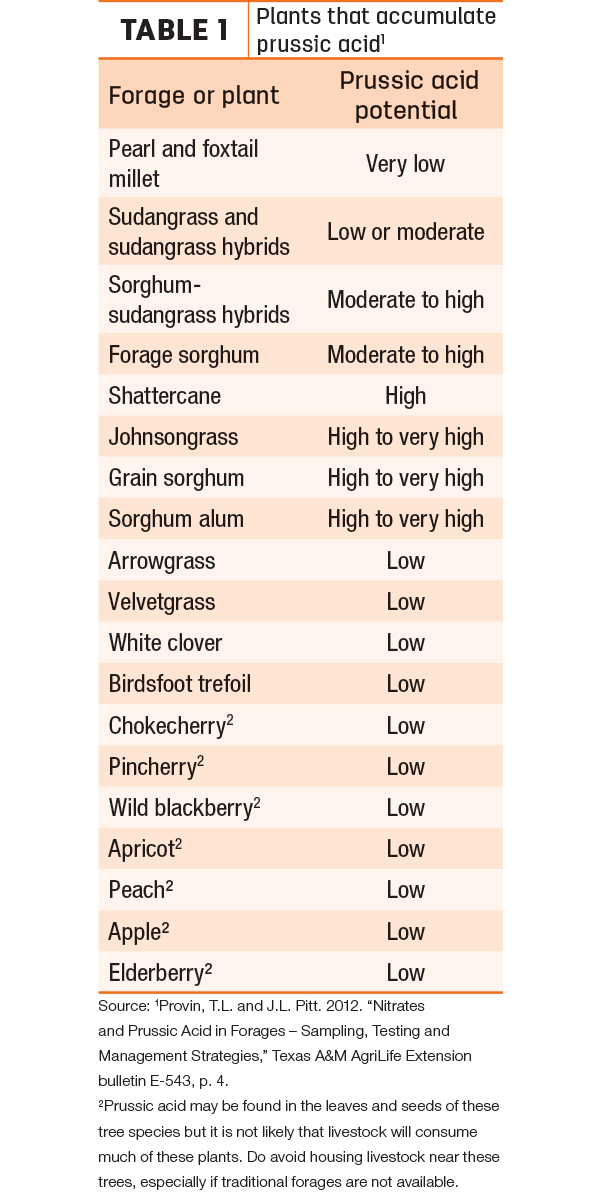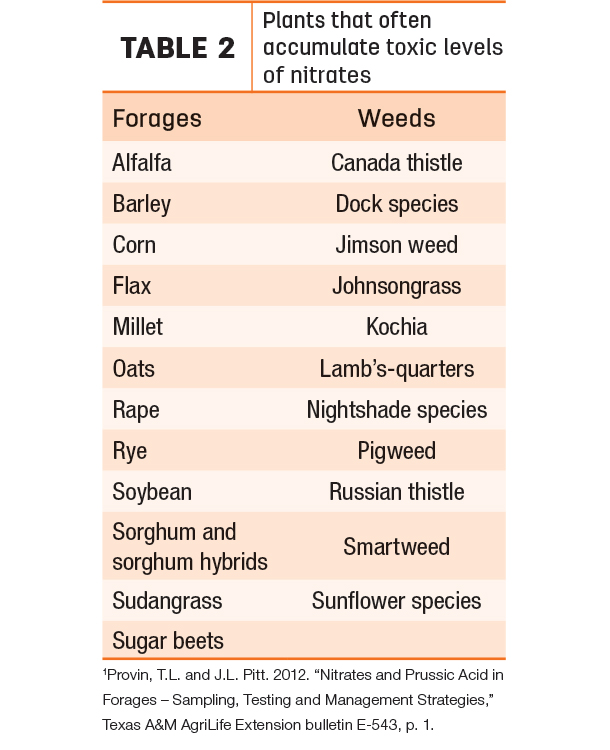Aflatoxins are especially a threat to dairy farmers because they can render milk unsalable as well as adversely affect animal health. In drought areas, monitor locally grown crops for aflatoxin, prussic acid and nitrates through forage analysis.
Aflatoxins
Aflatoxin, fumonisin and the fusarial toxins (vomitoxin, zearalenone and T-2 toxin) are significant mycotoxins in animal feed. Mycotoxins are toxic metabolites produced by fungi (molds) and are found in grain, usually grown in a drought. Aflatoxins are produced by Aspergillus flavus fungi. Crops affected by aflatoxins are primarily corn, cottonseed, peanuts and their byproducts. Corn in the field is more prone to aflatoxin infestation during drought than when adequate soil moisture is present.
“M1 is the primary strain of aflatoxin excreted in urine and milk,” says Michelle Arnold, Ph.D., University of Kentucky Veterinary Diagnostic Laboratory. “Aflatoxin M1 appears quickly in milk after consumption of contaminated feed. The amount excreted varies with type of livestock, individual animal, lactation status and number of times the female is milked after exposure.”
“Strains of Aspergillus flavus mainly produce aflatoxin B1, which is considered the most toxic and carcinogenic of the aflatoxins. For these reasons, many governments regulate allowable concentrations of aflatoxins in animal feed, human foods and fluid milk. The United States Food and Drug Administration (FDA) limits concentrations of aflatoxin in lactating dairy cow feed to 20 parts per billion (ppb) and the aflatoxin metabolite M1 to 0.5 ppb in milk. When the limit is exceeded in milk, the product is discarded and the dairy farmer is not paid,” Arnold says.
Aflatoxin M1 at illegal levels not only causes the dairy farmer to lose milk sales, but it also adversely affects animal health and production. Reduced appetite, feed efficiency and weight gain can result from aflatoxicosis, the disease caused by aflatoxins. Other visible symptoms include listlessness, rough hair coat, mild diarrhea and anemia with bruises and subcutaneous hemorrhages. Aflatoxicosis can also reduce milk production and immune response to vaccines, cause abortions and damage the liver.
Prussic acid
“Prussic acid is also known as hydrocyanic acid or hydrogen cyanide (HCN),” says Dale Fjell, Ph.D., professor emeritus, Kansas State University. “Poisoning of livestock by prussic acid is caused by cyanide production in several types of plants, some of which are listed in Table 1. Plants most commonly associated with prussic acid poisoning are sorghums and closely related species such as johnsongrass and sudangrass.”

Young, rapidly growing plants are likely to contain high levels of prussic acid because cyanide is more concentrated in young leaves than in older leaves or stems. New sorghum growth following drought or frost is extremely high in cyanide. Generally, any stress condition that retards normal plant growth may increase prussic acid content. Hydrogen cyanide is released when plants are physically damaged by trampling, cutting, crushing, chewing or wilting.
“Prussic acid is cyanogenic glycoside, a combination of sugar compounds and cyanide,” says Tony Provin from Texas A&M AgriLife Extension. “The sugar compounds break down in the cow’s rumen, freeing cyanide to form hydrocyanic acid (HCN). The HCN combines with hemoglobin to form cyanoglobin, which does not carry oxygen. As a result, livestock poisoned by cyanide develop respiratory stress.”
“Poisoning by prussic acid is very rapid after ingestion, frequently killing the animal within minutes,” Fjell says. “Symptoms include excess salivation, difficult breathing, staggering, convulsions and collapse. Death from respiratory paralysis follows shortly. Animals with cyanide poisoning have bright red blood that clots slowly. The smell of bitter almonds is often detected.”
“Since the highest concentrations of prussic acid are found in new growth leaves and cattle eat leaves before stems, forage samples for analysis should largely consist of leaves. If a limited grazing system is used, cattle will eat very few stems,” Provin says. “Unlike nitrates, prussic acid may volatilize from cut forages. The amount of volatilization in samples is reduced by placing them in resealable plastic bags or pint glass jars. When filling the bag or jar, leave 25 to 50 percent head space.”
Nitrates
“Nitrate toxicity is a misnomer because nitrite (NO2), not nitrate (NO3), is poisonous to animals. After a plant is eaten, rumen bacteria rapidly reduce nitrates in the forage to nitrites,” Fjell says. “Normally, nitrites are converted to ammonia and used by rumen bacteria as a nitrogen source. If nitrate content of forage is high and its intake by a cow is faster than its breakdown in the rumen, nitrites will begin to accumulate. The accumulated nitrite is rapidly absorbed into the bloodstream where it oxidizes hemoglobin to methemoglobin. Red blood cells containing methemoglobin cannot transport oxygen and the animal dies from asphyxiation.”
Some of the plants capable of accumulating toxic levels of nitrate are listed in Table 2.

“The first indication of nitrate toxicity may be one or more dead animals while others in the herd are exhibiting visual signs of poisoning,” says Arnold. “These first signs include weakness; rapid, labored breathing; rapid, weak heartbeat; staggering; muscle tremors; and inability to stand. Affected animals typically show evidence of poisoning within a few hours after consumption of a toxic dose of nitrates.”
“Examination of mucous membranes, especially the vaginal mucous membranes, may reveal a brownish discoloration that occurs well before other visual signs,” Arnold says. “Chocolate-colored blood and a brownish cast to all tissues are hallmark symptoms of nitrate poisoning. Most deaths occur within the first six to eight hours after onset of clinical signs. Amount of time before death largely depends on the quantity and rate of nitrite absorption, and amount of stress or exercise the animal is forced to do. After death, nitrate concentrate can be measured in eye fluid and is a reliable indicator of poisoning. Pregnant cows that survive toxicity will likely abort three to seven days following recovery from nitrate poisoning.”
“The highest nitrate accumulation is in the lower stem and the least is in leaves,” says Provin. “Forage species and grazing method should dictate how plant samples are taken for forage analysis. Remove only the upper one-third to one-half of the plant if limit grazing is practiced on traditional grasses, small grains or legumes. These are the plant parts cattle will consume. When limit grazing corn, sorghum, sorghum-sudangrass and similar forages, sample only the plant leaves. For rotational or single-field grazing systems, sample the lower one-third to one-half of traditional grasses and small grains, and the lower one-third of corn, sorghum and sorghum-sudangrass stalks. In these two grazing systems, cattle will consume not only the leaves and upper plant parts, but also the stems, which contain the highest nitrate concentrations.
Proper sampling of environmentally stressed forage is essential for preventing aflatoxin, prussic acid or nitrate poisoning. Visit with the appropriate state analytical laboratory to learn how to collect, package and ship forage samples. The knowledge may save your herd and pocketbook. ![]()
Robert Fears is a freelance writer based in Georgetown, Texas. Email Robert Fears.
PHOTO: Illustration by Kristen Phillips.









